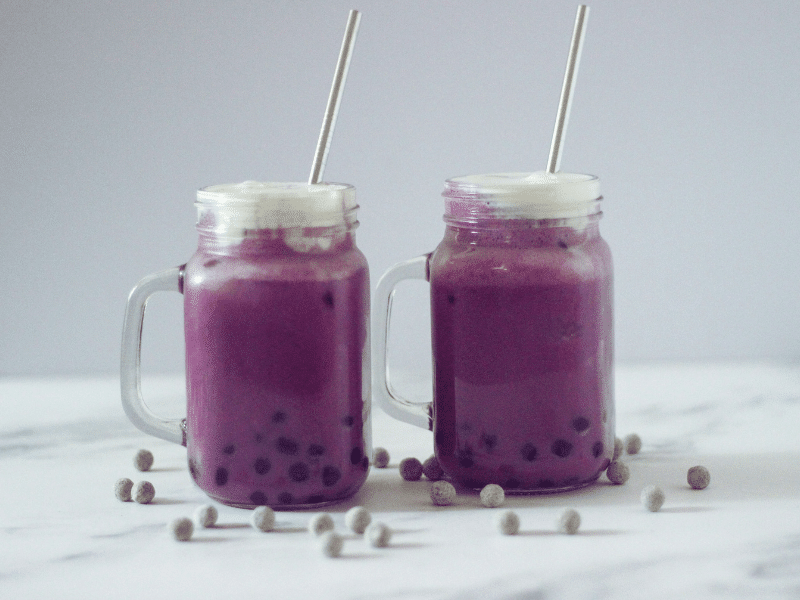Taro milk tea, with its distinctive purple hue and sweet, nutty flavor, has risen from its traditional roots to become a global sensation in the world of bubble tea and beyond. This delightful beverage merges the rich cultural heritage of tea with the unique taste of taro, a root vegetable that has been a staple in various cuisines for centuries. In our article, “What Is Taro Milk Tea,” we embark on a flavorful journey to uncover the origins, ingredients, and appeal of this popular drink, offering readers a comprehensive understanding of its place in both traditional and modern culinary landscapes.
Crafted with expertise and a genuine passion for exploring the world of teas and their accompanying flavors, this piece is designed to not only answer the basic question of what taro milk tea is but to delve deeper into the nuances that make it a beloved choice among tea enthusiasts around the globe. From the cultivation of taro to the art of tea brewing, and the innovative addition of tapioca pearls, we explore every facet of taro milk tea’s creation, including its health benefits and variations.
Our approach is aimed at both the uninitiated, who may be curious about trying taro milk tea for the first time, and seasoned aficionados looking to deepen their appreciation for this complex beverage. By detailing the cultural significance of taro and its evolution into a key ingredient in contemporary tea culture, we strive to enrich the reader’s understanding and encourage further exploration into the fascinating world of flavored teas.
Join us as we peel back the layers of taro milk tea, revealing not just the components and preparation techniques, but the stories and traditions that have propelled this drink from local specialty to international favorite. Whether you’re a fan of bubble tea looking to explore new flavors or a culinary adventurer eager to expand your palate, this article promises to engage, inform, and inspire your next tea-tasting adventure.
Definition and Alternative Names
Taro milk tea, also known as taro bubble tea or taro boba, is a popular drink that originated in Taiwan. It is a type of milk tea made with taro, a starchy root vegetable known for its sweet, nutty flavor. Taro milk tea is typically served over ice and topped with chewy tapioca pearls, adding a fun and satisfying texture to the beverage. The drink is made by blending taro with milk, sugar, and other flavorings to create a smooth and creamy mixture, which is then combined with cooked tapioca pearls. Taro milk tea offers a unique taste that is sweet, slightly nutty, and often compared to vanilla with a hint of nuttiness due to the taro roots.
Semantic Triples
| Entity | Attribute | Value |
| Taro milk tea | Alternative names | Taro bubble tea, taro boba |
| Taro milk tea | Place of origin | Taiwan |
| Taro milk tea | Time period of origin | 1980s |
Ingredients
Taro milk tea contains a few main ingredients that give it its distinctive flavor and texture:
- Taro root – The starchy root vegetable gives taro milk tea its signature purple color and creamy, nutty flavor. It can be used fresh, powdered, or as an extract.
- Milk – Dairy or non-dairy milk is blended with the taro to create a smooth, creamy drink. Common choices are cow’s milk, soy milk, almond milk, and coconut milk.
- Sugar – Sugar balances and enhances the earthy taro flavor. Brown sugar is commonly used.
- Tapioca pearls – Small pearls of tapioca starch that are chewy in texture. Tapioca pearls are cooked until soft and added to the milk tea.
Semantic Triples
| Entity | Attribute | Value |
| Taro milk tea | Main ingredients | Taro root, milk, sugar, tapioca pearls |
Preparation Methods
There are two main methods for preparing taro milk tea:
Using Fresh Taro
- Wash, peel, and cut taro root into cubes.
- Boil or steam taro until very soft.
- Blend cooked taro with milk and sugar until smooth.
- Pour taro milk mixture over ice.
- Add cooked tapioca pearls.
Using Taro Powder
- Combine taro powder with hot milk and sugar. Whisk well to dissolve powder.
- Allow taro milk mixture to cool.
- Pour over ice and add tapioca pearls.
Key Points
- Fresh taro has the best flavor, but requires more prep work. Taro powder is more convenient.
- Getting the right balance of taro and milk is key for ideal creaminess.
- Chilled taro milk tea with still-warm tapioca pearls provides an interesting hot and cold contrast.
Making Taro Milk Tea at Home
Here is a simple guide to making refreshing taro milk tea at home:
Ingredients
- 1 cup water
- 1/4 cup tapioca pearls
- 1/2 cup cubed taro root
- 2 cups milk of choice
- 2-3 tbsp brown sugar
- Ice cubes
Step-by-Step Instructions
- Bring 1 cup water to a boil. Add tapioca pearls and cook for 15 minutes until translucent. Drain and set aside.
- Meanwhile, boil or steam taro cubes for 20 minutes until very soft. Allow to cool slightly.
- Blend together taro, milk, and brown sugar until smooth and creamy.
- Pour taro milk mixture over ice cubes in a tall glass. Top with cooked tapioca pearls.
- Serve immediately and enjoy.
Tips
- Soak tapioca pearls in water for 30 minutes before boiling for best chewiness.
- Adjust sugar based on preference.
- For convenience, use taro powder instead of fresh taro.
- Play around with different milk varieties like coconut or oat milk.
Common Mistakes
- Undercooking the taro, resulting in grainy texture.
- Overcooking the tapioca pearls, making them mushy.
- Not dissolving the taro powder thoroughly into the milk.
- Adding too much or too little sugar.
Nutrition and Health Benefits
Taro milk tea provides a variety of key vitamins and minerals:
- Fiber – Helps promote healthy digestion.
- Vitamin E – An antioxidant that benefits skin and immune health.
- Vitamin B6 – Supports red blood cell production.
- Potassium – Important for heart function and managing blood pressure.
- Manganese – Involved in bone development and metabolism.
The taro root also contains taro starch that is easily digested and low on the glycemic index. This makes it suitable for people with certain dietary restrictions like diabetes. Overall, taro milk tea can be part of a balanced diet when consumed in moderation.
Cultural Significance and History
Taro has long been cultivated as a staple crop in Taiwan for over 300 years. It holds cultural importance and is featured prominently in Taiwanese cuisine. Taro features heavily in desserts, porridges, breads, and cakes.
The creation of taro milk tea is credited to Liu Han-Chieh, who invented it in the 1980s in Taiwan. The sweet, creamy drink quickly became popular across the country. In the late 1990s it began gaining popularity overseas as bubble tea cafes started popping up around the world.
Today it remains one of the most beloved tea flavors in Taiwan and abroad, known for its unique flavor and chewy texture.
Taro Milk Tea Variations to Try
The versatility of taro milk tea has allowed creative iterations of the drink to arise. Some popular variations include:
- Taro Iced Coffee – Taro blended with espresso and milk over ice.
- Taro Latte – Made like a hot coffee latte, but with taro puree instead of espresso.
- Taro Frappuccino – Blended taro with milk, ice, and sometimes coffee.
- Taro Coconut Milk Tea – Uses coconut milk for dairy-free creaminess.
- Taro Matcha Milk Tea – Combines the flavors of taro and matcha green tea.
While taro can be paired with many ingredients, it has an unmistakable flavor that sets it apart from other popular milk teas.
Consumer Insights and Trends
Taro milk tea is cherished by bubble tea fans for its unique earthy sweetness. In consumer surveys, fans praise both its taste and texture:
“Taro milk tea is my absolute favorite. I love its creamy texture and how the taro flavor is sweet and complex.”
“That beautiful lavender color is so Instagrammable. And it tastes like no other milk tea out there.”
Trends show that taro remains one of the top 3 most-ordered bubble tea flavors, though preferences fluctuate by region. Consumers also enjoy customizing their taro milk tea with add-ins like pudding or fruit jelly.
In recent years, taro milk tea has exploded from niche tea shops into mainstream cafes. Its popularity only continues to grow worldwide.
Sourcing Quality Ingredients
To make great taro milk tea, it all comes down to the ingredients:
High Quality Taro
Seeking out high grade, fresh taro ensures the richest flavor and color. Imported taro from Taiwan is ideal but high quality local taro also works well. Stay away from taro that is sprouting or looks moldy.
Perfect Tapioca Pearls
The best tapioca pearls are made from natural brown sugar without artificial additives. They should be perfectly chewy but not mushy. Look for large, consistent pearls vs. broken uneven ones.
Shop at specialty Asian grocers for access to premium taro, milk tea mixes, and tapioca pearls. When buying taro powder, check the ingredients to avoid fillers.
Environmental and Ethical Considerations
Taro cultivation requires ample water. Over-harvesting has raised environmental concerns in some regions. When sourcing taro, look for sustainably-grown varieties.
For bubble tea shops, using biodegradable cups and straws reduces plastic waste. Ethical companies also practice fair labor policies and ethically source ingredients like sugar. As consumers learn more about sustainability, they increasingly support companies with eco-friendly practices.
Frequently Asked Questions
What milk alternatives work best in taro milk tea?
Soy milk and almond milk both pair very nicely with taro, providing creaminess without overpowering the taro flavor.
How long does brewed taro milk tea last in the fridge?
It will stay good for up to 4-5 days refrigerated. Tapioca pearls harden when refrigerated so should be added fresh right before drinking.
Can I make taro milk tea without tapioca pearls?
Absolutely. The taro milk blend on its own is equally delicious. Some also enjoy taro milk tea with coffee jelly, grass jelly, or fruit jelly cubes instead of tapioca.
What’s the difference between purple and pink taro milk tea?
The purple color comes from actual purple taro variety roots. Pink taro milk tea uses white/pink taro roots but gets its color from additions like beetroot powder.
Conclusion
With its irresistible taste and texture, taro milk tea has earned its place as a bubble tea staple adored by tea connoisseurs worldwide. This root vegetable drink seamlessly blends sweet, nutty taro flavor with creamy milk and chewy tapioca pearls. Part of taro milk tea’s appeal lies in the many possible ways to enjoy it. Next time you visit a boba shop, consider trying taro milk tea in one of its classic or unique iterations. From a simple homemade recipe to customized cafe creations, taro milk tea is a comforting, indulgent drink worth exploring.

